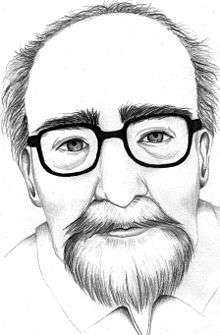Ramón J. Sender
| Ramón J. Sender | |
|---|---|
 | |
| Born |
Ramón José Sender Garcés February 3, 1901 Chalamera, Spain |
| Died |
January 16, 1982 (aged 80) San Diego, USA |
| Occupation | Professor |
| Language | Spanish |
| Nationality | Spanish |
| Citizenship | American |
| Literary movement | Post-Spanish Civil War literature |
Ramón José Sender Garcés (February 3, 1901 – January 16, 1982) was a Spanish novelist, essayist and journalist.
Life
Ramón J. Sender was born in Chalamera, Huesca, in Spain. In 1923 he was conscripted into the Spanish military and took part in the Rif War (1919–26). Later that year he returned to Madrid, where he worked as a journalist for El Sol, a newspaper critical of the current government. In 1926 he was imprisoned for writing Casas viejas. When the Spanish Civil War began in 1936, he immediately enlisted to help resist Franco. While Sender was at the front, the Nationalists executed his wife, Amparo Barayón, in Zamora,[1] and his brother in Huesca.[2] Sender had been an anarchist and then a communist but following the Spanish Civil War he reneged this ideology and sought asylum in France in 1938. He left Spain for New York after the Spanish Civil War in 1939, and then relocated to Mexico like many scientists, artists and intellectuals during the government of Lázaro Cárdenas. He became an American citizen in 1948, and he lived in the United States until 1972, when he returned to live in Spain for several years before dying in San Diego, California, in 1982.
Sender's oldest son is the composer and writer Ramon Sender. One of his several grandchildren is Chicago-based designer Sol Sender, best known for the development of the Obama campaign logo. The Spanish actor and showman Raúl Sender is his nephew.
Work
His most famous works include La tesis de Nancy, about the experiences of a young American student in Spain named Nancy, and Réquiem por un campesino español. La tesis de Nancy is widely read by Spanish students. The book is a true account based upon a series of letters written by Nancy (originally in English) from Nancy to her aunt. At the time Nancy was studying and living in Spain. She shared with her aunt her love for learning and exploring the Spanish language.
Publications
- Imán (1930)
- Seven Red Sundays (1932. Penguin 1938) (orig. Spanish. Siete domingos rojos)
- Mr. Witt en el cantón (1935)
- El lugar de un hombre (1939)
- Mexicayotl (1940)
- Crónica del alba (1942)
- La esfera (1947)
- El rey y la reina (1949)
- Mosén Millán (1953) (republished later in 1960 renamed as Requiem por un campesino español)
- Bizancio (1956)
- Requiem for a Spanish Peasant (1960) (orig. Spanish. Requiem por un campesino español republished in)
- El bandido adolescente (1965)
- La aventura equinocial de Lope de Aguirre (1968)
Notes
- ↑ Sender Barayon, Ramon, A Death in Zamora, Calm University Press. 2003, p. 34
- ↑ Ramón J. Sender Garcés (1901-1982)", Centro Virtual Cervantes.
External links
- Profile (Spanish)
- Biography (Spanish)
- Ramón J. Sender: One of the most important Spanish expatriate writers (Spanish)
- Ramón J. Sender at Find a Grave